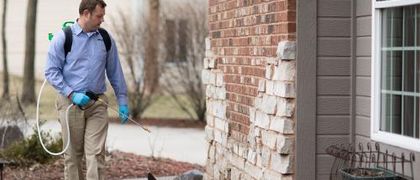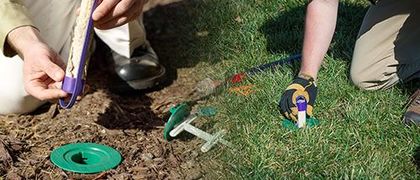What Attracts Fleas To Your Yard?
Fleas have an impressive ability to leap high in the air—well, high for them. A human with the ability to leap as high as a flea (relatively speaking), could jump over a two-story home. However, while fleas have an impressive ability to jump, they don't jump more than two feet. They also do not typically use their jumping ability to get from one yard to another. If you have fleas in your yard, it isn't because you attracted fleas to your yard. What happened is you attracted animals that carry fleas. Join us today as we look at what brings fleas into your yard and, most importantly, what you can do about them.

Public transportation for fleas
Fleas hop onto warm-blooded animals and live in the fur (or hair) near the skin, drawing blood meals as needed for survival. The common animals that bring fleas into our yards are mice, rats, squirrels, raccoons, skunks, bats, and birds.
Let’s break it down a bit further, starting with rodents. Mice, rats, and squirrels are looking for seeds, nuts, and fruit in your yard. If you want fewer fleas and ticks, your first step is removing food sources. Get rid of bird feeders or put them well away from your exterior. Remove fruit that is overripe or rotting and rake nuts up routinely. Trash cans are another magnet for rodents, so be sure to keep the lid on exterior bins and not pile up garbage bags, boxes, and other trash around them.
Speaking of trash cans, raccoons, skunks, and other wildlife are also attracted to human refuse. The trash can tips mentioned above will help deter these critters, too. Other tips to discourage wildlife include harvesting your garden as often as possible and sealing off access under porches, decks, and crawl spaces.
It is hard to keep birds and bats away from your property, but you can take steps to keep them from entering your home. Use expanding foam to fill in structural gaps and holes. Doing so may prevent an interior flea problem.
Where fleas develop & how to stop them
One house mouse can have a hundred fleas. When it explores the exterior of your home, it hides in vegetation and underneath structures, which provide shade and humidity for flea development.
- Flea eggs and flea dirt fall from the animal.
- The eggs hatch, and larvae emerge.
- The larvae feed on the flea dirt.
- In a shaded and humid area, the larvae may survive, pass through the pupal stage, and grow into adult fleas.
When your pet goes outdoors and travels near tall grass, plants, and weeds, it can pick up fleas. You may reduce the chance that your pet will get fleas by keeping plants trimmed and allowing sunshine to dry your vegetation. You may further reduce the risk by removing yard clutter and addressing rodent problems. These steps alter conditions that are conducive to flea development.
More flea prevention tips
We touched on two important ways to reduce your chances of having a flea infestation in your home: making your yard less attractive to wild animals and addressing conditions that promote flea development. But there are other ways to prevent a flea infestation in your home.
- Mow regularly and address the weeds that pop up.
- Avoid over-watering your grass.
- Remove leaves, branches, and other organic debris that create shady, humid breeding sites.
- Check with your veterinarian to find out what flea preventative is right for your pets.
- Vacuum your pets’ beds regularly and other areas where they tend to rest.
- Do not let your pets sleep in your bed.
Now that you know what you can do to prevent a flea infestation, let's look at what pest management professionals can do to help you stop these irritating pests.
Contact Miller for professional flea control
The team at Miller Pest & Termite provides Miller Guard, a comprehensive home pest control plan, for managing flea and pest infestations in homes and yards in Omaha, Kansas City, and Des Moines, as well as throughout our Midwest service area. This year-round plan is designed to eradicate existing pest problems and prevent new infestations from occurring. Please take a look at the plan's features and covered pests mentioned below or feel free to contact us if you have any questions.
Ongoing Home Pest Control Recommendation
Miller Guard
Our signature Miller Guard pest control plan stands out in the industry by giving you Full Pest Coverage and Zero hidden fees. It is designed to eliminate and prevent insect and rodent problems by targeting pest entry and exit points for maximum effectiveness. It includes an initial premium interior application, exterior applications, web removal, and wasp nest removal.
- Ongoing Preventive Services
- 29 Pests & Services Covered
- Initial Premium Interior Application
- Exterior Applications
- Rodent Control
- Wasp Nest Removal
- Cob-Web Removal
- 1-Year Service Agreement
Starting at:
$4999A Month
Free Quote Or Call (515) 518-8864

Additional Miller Guard Details
Pests Covered: Asian Beetles, Boxelder Bugs, Carpenter Ants, Carpet Beetles, Centipedes, Clothes Moths, Drain Flies, Earwigs, Fleas, Fruit Flies, Grain Beetles, Hornets, House Ants, Indian Meal Moths, Mice, Millipedes, Pill Bugs, Rats, Roaches**, Silverfish, Spiders***, Stink Bugs, Wasps, Weevils, Yellow Jackets
Service frequency will vary based on geography. The Miller Guard program does not include the following pests: honey bees, flies, lice, dust mites, mosquitoes, exterior ticks, ornamental/turf pests, slugs, snails, termites, wildlife, birds, and brown recluse spiders.
- Pricing does not include initial fee
- Must have credit card on file
**American, German & Oriental
*** Venomous & Non-venomous
Get Help Now!










